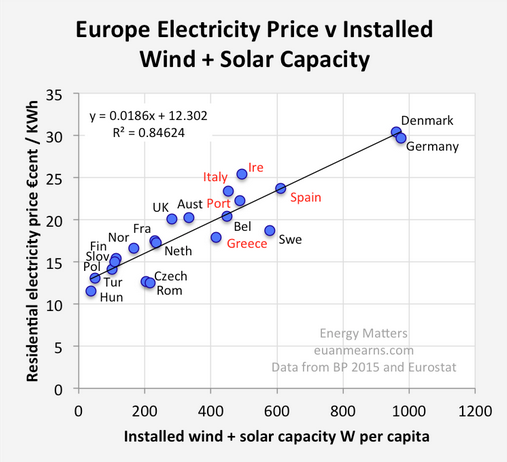With due deference to Steve Sailer, one of the most important graphs of these times plots the penetration of wind and solar generation in European countries against residential electricity prices. The correlation is clear: the more wind and solar generation, the higher electricity prices. With Europe being the most mature – or most suicidally determined – on the “Net Zero” path, this graph is a good indicator of what awaits the rest of us.

Or is already here: Australians have had to watch their power bills soar, despite repeated promises to the contrary, as the Albanese government foists its unhinged “Net Zero” plan on the country. South Australia, which regularly brags of closing its coal-fired power, has the highest power prices in the country. For a while, SA led the world for expensive electricity. In an effort to stave off bad news about poorer Australians having to choose between heating and eating (as happens every winter to thousands of Britons), governments are frantically doling out relief payments.
It’s on track to get a whole lot worse. In order to avoid the growing backlash over the proliferation of ugly, noisy, environmentally disastrous wind farms, Victoria and NSW are determined to shift more generation to offshore wind. While it conveniently – for governments – hides the farms well out to sea, wind is also one of the most ruinously expensive ways to make electricity.
How expensive? Don’t ask, because they won’t tell you.
The detailed costs are being kept secret so I have done my best to obtain “the truth” and my calculations (obtained from experts who are not insiders) will stand until Victoria and NSW reveal the costs to their voters and industry.
I believe the two states are locking in huge power costs which will require massive tax payer subsidies to be economic. Once those offshore wind costs are understood, the cost aspect of the nuclear debate ends: nuclear power is much cheaper than offshore wind.
The big costs, both for nuclear and wind, are not in the operation, which is quite low, but in the construction.
Accordingly, the issue for the electricity consumer is the installed cost paid upfront by power investors. This outlay must be recouped over the life of the plant as well as delivering a return on investment.
In other words, consumers will end up paying for the construction as well as the operating costs. Paying a lot.
The generally accepted cost of offshore wind construction is between $3.5m to $4.5m per installed MW.
A recent UK offshore wind development cost $4.5m per installed MW. The Bass Strait would be easier but construction is in the future so costs will increase. Let’s assume a Bass Strait cost of $4m per MW.
The other caveat is that “installed capacity” is not the same as actual generation. “Installed capacity” is a theoretical figure, assuming the entire installation is working at maximum capacity. In the real world, this is almost never.
Some of the estimates from Bass Strait suggest only 30 per cent of the installed capacity would actually be generated but, again, being generous to wind, let’s assume 40 per cent of the nominal power generation capacity is actually produced.
This means to generate one MW will cost around $10m because an extra one and a half plants must be built.
So, what about nuclear? Unlike wind or solar plants, nuclear plants operate at full efficiency almost all of the time.
The United Arab Emirates, the first of the Arab nations to install nuclear power, is installing four nuclear reactors of 1400MW each with the first up and running.
This was built by the South Korean group KEPCO and took eight years to build. The cost was $6.5m per installed MW with a life estimate of 80 years.
Nuclear power plants might lose, say, six or seven per cent of generating capacity for maintenance, but in essence the base cost of erecting plants to generate one MW is around $6.5m for nuclear and $10m for offshore wind. This puts nuclear way out in front.
Note too, that life estimate of 80 years for a nuclear plant? Wind turbines don’t last anywhere near so long. Even the best cutting-edge turbines only last about 20 years.
The people who have the knowledge to make likely price calculations say if everything went right it might be possible to gain a return by charging $150 per MWh but it is much more likely to require a price of around $200 per MWh. To this must be added the costs of delivering the power to the customer.
The Dutton opposition’s plan is to build latest-technology nuclear plants on the sites of dismantled coal stations. Meaning, in effect, that no new transmission networks need be built. Getting power from wind farms far out to sea to consumers in Melbourne or Sydney is a whole other, vastly expensive, challenge.
So, Victoria is going to saddle itself with power which costs three to four times the old coal priced power. All the indications suggest NSW offshore power will be even more expensive.
Sending the price of electricity through the roof isn’t just a budget-breaker for household electricity consumers. When the price of energy goes up, the price of everything goes up. Including the industrial base that is essential to the defence of a nation.
The Chinese Communist Party, frantically building as many coal plants as it can, surely cannot believe its luck at the suicidal insanity of Western governments.









